Chapter 4. Membranes and Transport
4.4 Active Transport
Learning Objectives
By the end of this section, you will be able to:
- Compare and contrast active transport and passive transport across cell membranes
- Define primary and secondary active transport
- Compare and contrast the membrane transport processes primary active transport and secondary active transport with respect to the direction of movement relative to the concentration gradient, the energy source for the movement, the properties of the substance(s) transported, and whether a transport protein is involved
- Compare and contrast modes of transmembrane vesicular transport with respect to their mechanisms, the direction of movement, and the type of material being moved
For all diffusion, facilitated diffusion, and osmosis, the cell expends no energy. Membrane proteins that aid in the passive transport of substances do so without the use of adenosine triphosphate (ATP). During primary active transport, ATP is required to move a substance across a membrane, with the help of membrane protein, and against its concentration gradient.
One of the most common types of active transport involves proteins that serve as pumps. The word “pump” probably conjures up thoughts of using energy to pump up the tire of a bicycle or a basketball. Similarly, energy from ATP is required for these membrane proteins to transport substances—molecules or ions—across the membrane, against their concentration gradients (from an area of low concentration to an area of high concentration).
The sodium-potassium pump, which is also called Na+/K+ ATPase, transports sodium out of a cell while moving potassium into the cell. The Na+/K+ pump is an important ion pump found in the membranes of all cells. The activity of these pumps in nerve cells is so great that it accounts for the majority of their ATP usage.
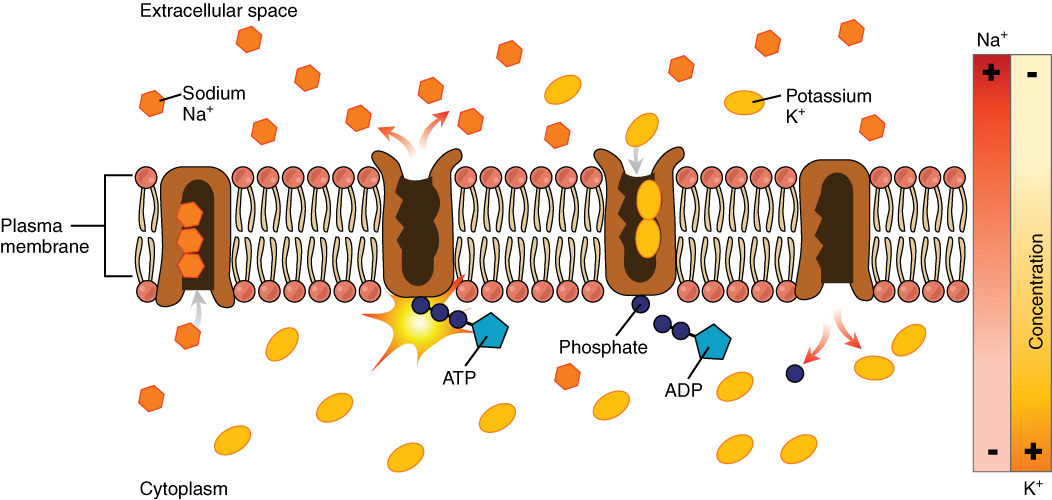
Active transport pumps can also work together with other active or passive transport systems to move substances across the membrane. For example, the sodium-potassium pump maintains a high concentration of sodium ions outside of the cell. Therefore, if the cell needs sodium ions, all it has to do is open a passive sodium channel, as the concentration gradient of the sodium ions will drive them to diffuse into the cell. In this way, the action of an active transport pump (the sodium-potassium pump) powers the passive transport of sodium ions by creating a concentration gradient. When active transport powers the transport of another substance in this way, it is called secondary active transport.
Symporters are secondary active transporters that move two substances in the same direction. For example, the sodium-glucose symporter uses sodium ions to “pull” glucose molecules into the cell. Since glucose is critically important to many cells of the body, cells have many mechanisms to bring glucose into or out of the cell under different environmental conditions. Cells often store glucose for energy, and as a result, glucose may be at a higher concentration inside the cell than outside; however, due to the action of the sodium-potassium pump, sodium ions will always be at a lower concentration inside the cell and will easily diffuse into the cell when the symporter is opened. The flood of sodium ions through the symporter down sodium’s concentration gradient provides the energy that allows glucose to move through the symporter and into the cell, against the concentration gradient of glucose (Figure 4.4.2).
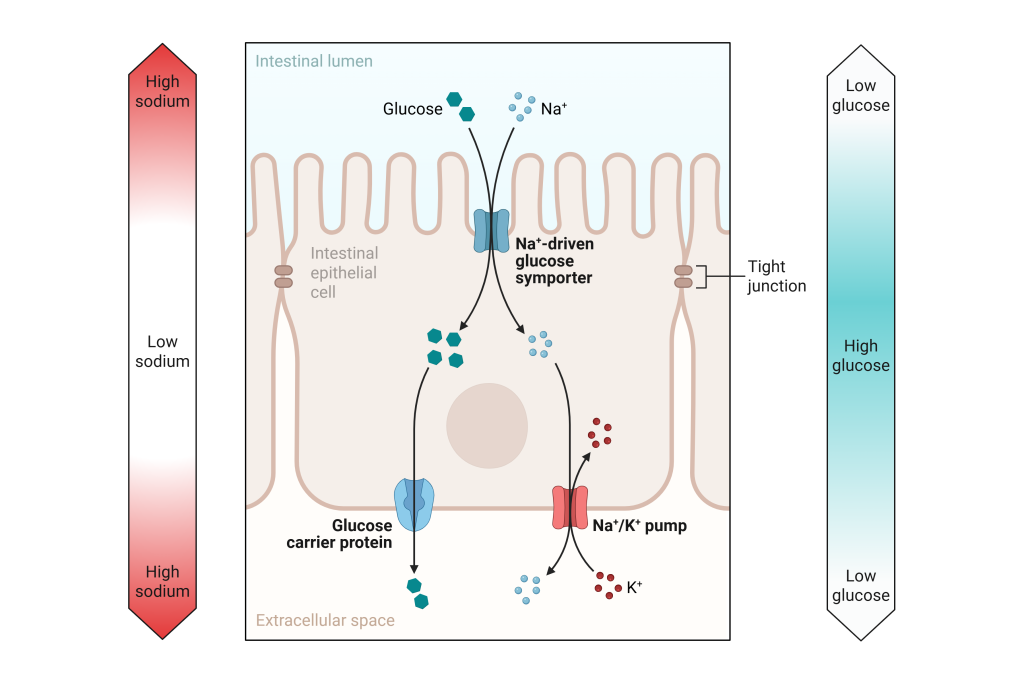
Conversely, antiporters are secondary active transport systems that transport substances in opposite directions. For example, the sodium-hydrogen ion antiporter uses the energy from the inward flood of sodium ions to move hydrogen ions (H+) out of the cell. The sodium-hydrogen antiporter is used to maintain the pH of the cell’s interior.
Vesicular Transport
Other forms of active transport do not involve membrane carriers. Endocytosis (bringing “into the cell”) is the process of a cell ingesting material by enveloping it in a portion of its cell membrane and then pinching off that portion of membrane (Figure 4.4.3). Once pinched off, the portion of membrane and its contents becomes an independent, intracellular vesicle. A vesicle is a membranous sac—a spherical and hollow organelle bounded by a lipid bilayer membrane. Endocytosis often brings materials into the cell that must to be broken down or digested. Phagocytosis (“cell eating”) is the endocytosis of large particles. Many immune cells engage in phagocytosis of invading pathogens. Like little Pac-Men, their job is to patrol body tissues for unwanted matter like invading bacterial cells, phagocytize them, and digest them. In contrast to phagocytosis, pinocytosis (“cell drinking”) brings fluid-containing dissolved substances into a cell through membrane vesicles.
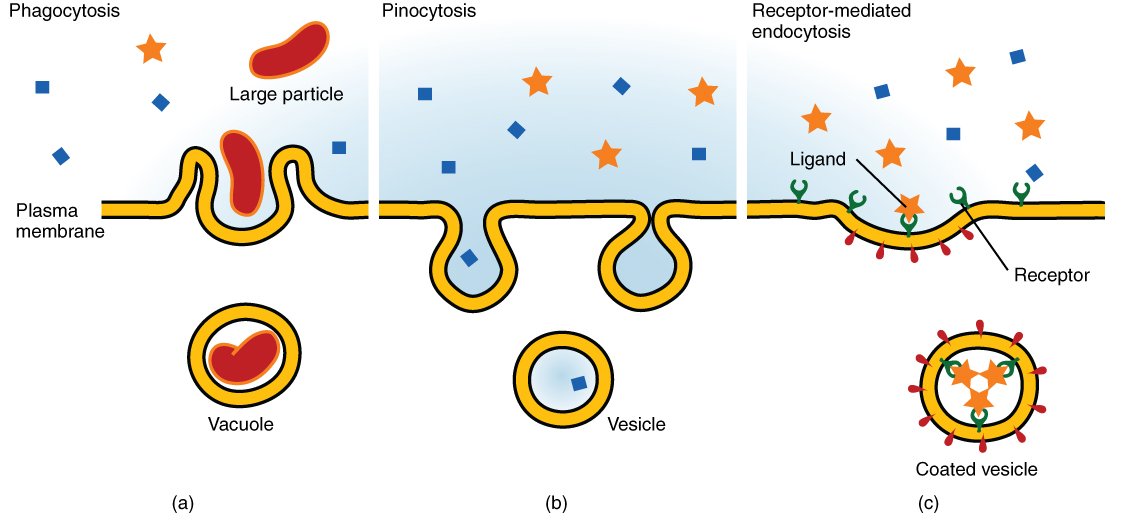
Phagocytosis and pinocytosis take in large portions of extracellular material, and they are typically not highly selective in the substances they bring in. Cells regulate the endocytosis of specific substances via receptor-mediated endocytosis. Receptor-mediated endocytosis is endocytosis by a portion of the cell membrane which contains many receptors that are specific for a certain substance. Once the surface receptors have bound sufficient amounts of the specific substance (the receptor’s ligand), the cell will endocytose the part of the cell membrane containing the receptor-ligand complexes. Iron, a required component of hemoglobin, is endocytosed by red blood cells in this way. Iron is bound to a protein called transferrin in the blood. Specific transferrin receptors on red blood cell surfaces bind the iron-transferrin molecules, and the cell endocytoses the receptor-ligand complexes.
In contrast with endocytosis, exocytosis (taking “out of the cell”) is the process of a cell exporting material using vesicular transport (Figure 4.4.4). Many cells manufacture substances that must be secreted, like a factory manufacturing a product for export. These substances are typically packaged into membrane-bound vesicles within the cell. When the vesicle membrane fuses with the cell membrane, the vesicle releases its contents into the interstitial fluid. The vesicle membrane then becomes part of the cell membrane. Specific examples of exocytosis include cells of the stomach and pancreas producing and secreting digestive enzymes through exocytosis (Figure 4.4.5) and endocrine cells producing and secreting hormones that are sent throughout the body.
The addition of new membrane to the plasma membrane is usually coupled with endocytosis so that the cell is not constantly enlarging. Through these processes, the cell membrane is constantly renewing and changing as needed by the cell.
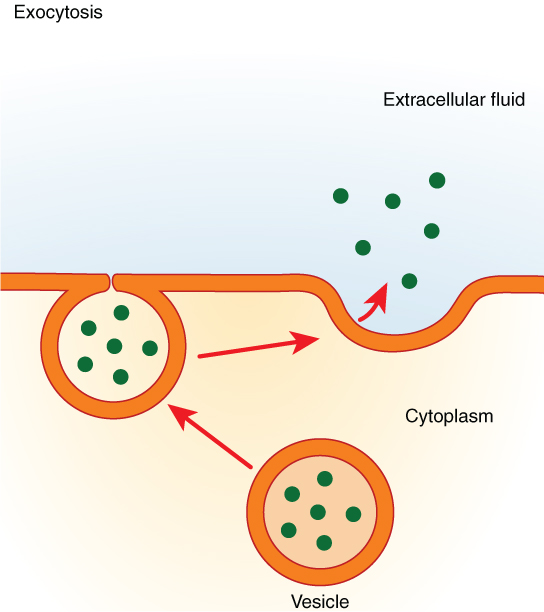
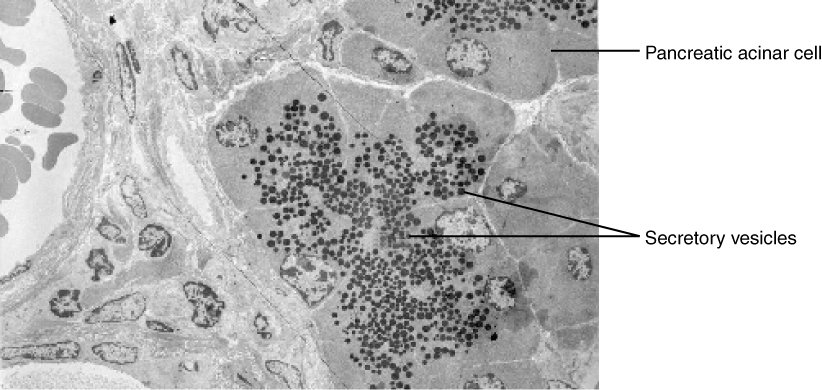
 View the University of Michigan WebScope to explore the pancreatic tissue sample in greater detail.
View the University of Michigan WebScope to explore the pancreatic tissue sample in greater detail.
Diseases of the Cell: Cystic Fibrosis
Cystic fibrosis (CF) affects approximately 30,000 people in the United States, with about 1,000 new cases reported each year. The genetic disease is most well known for its damage to the lungs, causing breathing difficulties and chronic lung infections, but it also affects the liver, pancreas, and intestines. Only about 50 years ago, the prognosis for children born with CF was very grim—a life expectancy rarely over 10 years. Today, with advances in medical treatment, many CF patients live into their 30s.
The symptoms of CF result from a malfunctioning membrane ion channel called the Cystic Fibrosis Transmembrane Conductance Regulator (CFTR). In healthy people, the CFTR protein is an integral membrane protein that transports Cl– ions out of the cell. In a person who has CF, the gene for the CFTR is mutated; thus, the cell manufactures a defective channel protein that typically is not incorporated into the membrane but is instead degraded by the cell.
The CFTR requires ATP in order to function, making its Cl– transport a form of active transport. This puzzled researchers for a long time because the Cl– ions are actually flowing down their concentration gradient when transported out of cells. Active transport generally pumps ions against their concentration gradient, but the CFTR presents an exception to this rule.
In normal lung tissue, the movement of Cl– out of the cell maintains a Cl–-rich, negatively charged environment immediately outside of the cell. This is particularly important in the epithelial lining of the respiratory system. Respiratory epithelial cells secrete mucus, which serves to trap dust, bacteria, and other debris. A cilium (plural cilia) is one of the hair-like appendages found on certain cells. Cilia on the epithelial cells move the mucus and its trapped particles up the airways away from the lungs and toward the outside. In order to be effectively moved upward, the mucus cannot be too viscous; rather, it must have a thin, watery consistency. The transport of Cl– and the maintenance of an electronegative environment outside of the cell attracts positive ions such as Na+ to the extracellular space. The accumulation of both Cl– and Na+ ions in the extracellular space creates solute-rich mucus, which has a low concentration of water molecules. As a result, through osmosis, water moves from cells and extracellular matrix into the mucus, “thinning” it out. In a normal respiratory system, this is how the mucus is kept sufficiently watered down to be propelled out of the respiratory system.
If the CFTR channel is absent, Cl– ions are not transported out of the cell in adequate numbers, thus preventing them from drawing positive ions. The absence of ions in the secreted mucus results in the lack of a normal water concentration gradient. Thus, there is no osmotic pressure pulling water into the mucus. The resulting mucus is thick and sticky, and the ciliated epithelia cannot effectively remove it from the respiratory system. Passageways in the lungs become blocked with mucus, along with the debris it carries. Bacterial infections occur more easily because bacterial cells are not effectively carried away from the lungs.
Section Review
Passive transport mechanisms such as diffusion, facilitated diffusion, and osmosis move substances across cell membranes without using energy, while active transport requires ATP to move substances against concentration gradients through membrane proteins like pumps. The sodium-potassium pump is a primary example, maintaining ion gradients that drive secondary active transport via symporters and antiporters. Endocytosis and exocytosis are additional active processes that use vesicles to import and export materials, including specific forms like phagocytosis, pinocytosis, and receptor-mediated endocytosis. In cystic fibrosis, a genetic mutation leads to a defective CFTR chloride channel, impairing ion and water movement in the respiratory tract. This results in thick mucus that cannot be effectively cleared, contributing to lung obstruction and chronic infections.
Review Questions
Critical Thinking Questions
Glossary
- active transport
- the movement of substances across a membrane using energy (typically from ATP), often against a concentration gradient
- antiporter
- a type of secondary active transporter that moves two substances in opposite directions across a membrane
- adenosine triphosphate (ATP)
- a molecule that stores and provides energy for many cellular processes, including active transport
- concentration gradient
- a difference in the concentration of a substance across a space or membrane
- endocytosis
- an active transport process in which a cell engulfs material by folding in its membrane to form a vesicle
- exocytosis
- a process by which cells expel materials using vesicles that fuse with the cell membrane
- phagocytosis
- a type of endocytosis where the cell engulfs large particles, such as pathogens or debris (“cell eating”)
- pinocytosis
- a type of endocytosis in which the cell ingests extracellular fluid and dissolved substances (“cell drinking”)
- primary active transport
- a form of active transport that directly uses ATP to move substances against their concentration gradient
- receptor-mediated endocytosis
- a selective form of endocytosis where specific molecules bind to receptors on the cell surface before being internalized in a vesicle
- secondary active transport
- a form of active transport that uses the energy from the movement of one substance down its concentration gradient to move another substance against its gradient
- sodium-potassium pump (Na⁺/K⁺ ATPase)
- a membrane protein that uses ATP to move sodium ions out of the cell and potassium ions into the cell
- symporter
- a type of secondary active transporter that moves two substances in the same direction across a membrane
- vesicle
- a small, membrane-bound sac that transports substances within or between cells
Glossary Flashcards
This work, Human Physiology, is adapted from Anatomy & Physiology by OpenStax, licensed under CC BY. This edition, with revised content and artwork, is licensed under CC BY-SA except where otherwise noted.
Images from Anatomy & Physiology by OpenStax are licensed under CC BY except where otherwise noted.
Access the original for free at OpenStax.
Image Descriptions
Figure 4.4.1. This educational illustration depicts active transport via the sodium-potassium pump across a cell plasma membrane. The diagram shows a cross-section of the “Plasma membrane” (labeled on left) as a phospholipid bilayer with pink circles as heads and white lines as tails, containing brown protein pumps. Text labels identify “Extracellular space” (top) and “Cytoplasm” (bottom). Orange hexagons labeled “Sodium Na⁺” and yellow ovals labeled “Potassium K⁺” represent ions in both compartments. Arrows show three sodium ions moving outward and two potassium ions moving inward through the pumps. “ATP”, “ADP”, and “Phosphate” labels indicate the energy source powering the transport. A concentration gradient bar on the right shows “Na⁺” with plus at top and minus at bottom, and “K⁺” with minus at top and plus at bottom, labeled “Concentration”, indicating the pump works against natural diffusion gradients by using energy from ATP hydrolysis to maintain higher sodium concentration outside and higher potassium concentration inside the cell. [Return to Figure 4.4.1]
Figure 4.4.2. This educational illustration depicts glucose absorption across an intestinal epithelial cell. The diagram shows a rectangular cross-section of an “Intestinal epithelial cell” (labeled in center) with the “Intestinal lumen” at top and “Extracellular space” at bottom. Pink/tan curved structures along the top represent microvilli with “Tight junction” (labeled on right) connecting adjacent cells. At the apical (top) membrane, a blue “Na⁺-driven glucose symporter” (labeled) simultaneously transports dark teal circles labeled “Glucose” and light blue circles labeled “Na⁺” from the lumen into the cell, shown by black arrows pointing inward. At the basolateral (bottom) membrane, a blue “Glucose carrier protein” (labeled on left) transports glucose out of the cell into the extracellular space via facilitated diffusion, and a red “Na⁺/K⁺ pump” (labeled on right) actively transports sodium out and dark red circles labeled “K⁺” (potassium) into the cell. Gradient arrows on the sides show: left side indicates “High sodium” (top) to “Low sodium” (middle) to “High sodium” (bottom), and right side shows “Low glucose” (top) to “High glucose” (middle) to “Low glucose” (bottom), illustrating concentration gradients that drive the transport processes. [Return to Figure 4.4.2]
Figure 4.4.3. This educational illustration compares three types of endocytosis across the cell plasma membrane. Panel (a) labeled “Phagocytosis” shows the “Plasma membrane” (yellow/gold outlined) extending outward to engulf a large red oval “Large particle” along with various smaller shapes (orange stars, blue squares, blue diamonds) in the extracellular space, forming a large internal “Vacuole” containing the engulfed material. Panel (b) labeled “Pinocytosis” shows the plasma membrane forming small inward pockets that pinch off to create tiny “Vesicle” structures containing small amounts of extracellular fluid with dissolved molecules (blue square shown inside vesicle). Panel (c) labeled “Receptor-mediated endocytosis” shows specific “Ligand” molecules (green shapes) binding to “Receptor” proteins (red structures) on the membrane surface, triggering the formation of a “Coated vesicle” (shown with red coating proteins on its surface) that contains the bound ligand-receptor complexes along with orange star-shaped molecules. Each panel demonstrates how cells can internalize different materials from their environment through distinct membrane-based mechanisms. [Return to Figure 4.4.3]
Figure 4.4.4. This educational illustration depicts the process of exocytosis, labeled “Exocytosis” at the top. The diagram shows a cell’s interior labeled “Cytoplasm” (pale yellow region at bottom) separated from the “Extracellular fluid” (light blue region at top) by an orange plasma membrane. A spherical “Vesicle” (labeled at bottom) containing green circles (representing molecules) is shown in the cytoplasm. Red arrows indicate the movement sequence: the vesicle moves toward and fuses with the plasma membrane, which then opens to release the green molecules into the extracellular fluid, where they are shown dispersing. The illustration demonstrates how cells package and export materials by enclosing them in membrane-bound vesicles that merge with the cell membrane to release their contents outside the cell. [Return to Figure 4.4.4]
Figure 4.4.5. This is a transmission electron microscope (TEM) image showing cellular ultrastructure in grayscale. Text labels with arrows identify key structures: “Pancreatic acinar cell” (pointing to the overall cell in the upper right) and “Secretory vesicles” (pointing to numerous small, dark circular structures densely packed in the center of the cell). The secretory vesicles appear as dark dots with lighter halos, representing membrane-bound compartments containing digestive enzymes. The surrounding cellular structures include various organelles visible as lighter and darker regions with different textures throughout the cytoplasm. This micrograph illustrates the specialized secretory function of pancreatic acinar cells, which produce and store digestive enzymes in vesicles before releasing them into the pancreatic duct. [Return to Figure 4.4.5]
Report an Error
Did you find an error, typo, broken link, or other problem in the text? Please follow this link to the error reporting form to submit an error report to the authors.
